I intend to connect students with works of art they have access to on any given day, yet may never have known existed. These artworks tell the history of the place they live and later will help them tell their own visual story. Through their investigation of these pieces, students will become familiar with the visual questions that will allow them to interpret the history behind the artwork.
To complete this project, students will need to visit on site locations of historic artworks from both the current Percent for Art projects and from many Public Works Art Projects of the 1930’s. Each student will create a journal where they will answer questions and create a personal representation of the artwork. We will explore such techniques as watercolor, pen and ink drawing, and pencil drawing as methods with which an artist can quickly capture the artworks. Students will be encouraged to place emphasis on what they find most interesting. Students will then be able to ask a variety of questions that will help them further understand the pieces and their meaning. Once the student evaluations and background knowledge have been established they are presented with questions such as: What is the title of the artwork? What time period or moment in history is the work intended to represent? Who created the artwork? Who commissioned the work and how did it influence the artist’s design? Why was this time, person or topic in history chosen for the site where it is located? Students will reformulate their interpretation as they complete their research and begin to understand the time period it was intended to represent, as well as the artist’s choices for its representation.
In collaboration with the Library Media Specialist, students will create lists of questions they have concerning the history of each artwork. Using online and library resources students will research these questions. At the conclusion of our research into New Haven’s history in public art, students will be asked to choose a moment in history they wish to represent in an artwork of their own. They will be asked to designate a site to display their work where it could be most effective and list persons and groups they would solicit for funding to install. Students will be asked to explain their choices for patrons and why.
Suggested Lesson One
Objectives
-
Students will develop critical thinking and observation skills
-
Students will be introduced to the genre of public art and engage in the analysis of art and artist intent.
-
To instill curiosity surrounding the discovery of the Americas
-
Students will experiment with pencil drawing techniques
Artwork:
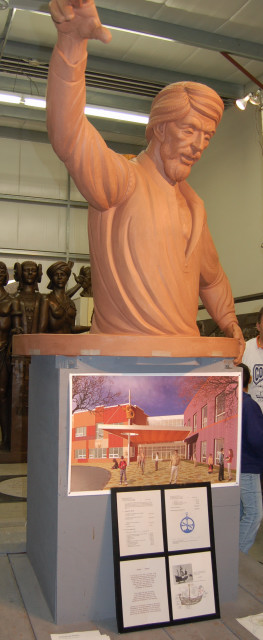
Photo of artwork in progress
Rodrigo de Triana
-
Artist: Jose Buscaglia
-
Date: incomplete
-
Material: Cast Bronze
-
Location: Christopher Columbus Family Academy
-
Sponsor: Percent for Art project
-
Description: This sculpture’s purpose is to represent a period of diverse change in the Americas and beyond. The artist hopes to inspire curiosity of events surrounding this specific encounter.
9
Juan Rodriguez Bermejo (Rodrigo de Triana) was a sailor on Columbus’s first voyage in 1492. There is question as to who on this voyage truly saw land first. It is disputed whether it was Columbus on the Santa Maria who lays claim to seeing a light in the distance or, Rodrigo on the crow’s-nest of the Pinta? Columbus received the fame and glory.
Materials:
-
Student journals
-
Drawing pencils
Background Information:
This sculpture will be unveiled after the opening of Columbus School’s new building. Great pomp and circumstance, newspaper articles and artist talks will accompany this occasion. I feel it will be a great way to seize the student’s attention.
Observations/Description:
Students will be asked to first observe the sculpture and visually record a description of what they see through a pencil drawing. Next they will be asked to answer the following questions as a form of analysis:
-
What emotions does this artwork evoke and why?
-
Who has the artist portrayed?
-
What time period is this person from?
-
What about the person makes you believe this?
-
Why do you believe this person is significant to our school and or community?
-
What are some other questions you may have about the artwork?
-
Read the plaque hung under the sculpture and add any changes to your thoughts.
-
Who do you believe may have commissioned this artwork and why?
-
What influenced the artist more the patron or environment?
Once students have all had a chance to share their thoughts concerning the sculpture we will learn about the artist and his intent by visiting Jose Buscaglia website.
Students will also engage in historical research concerning Columbus and Triana with the Library Media Specialist.
Interpretation:
Students will compare and contrast their pre and post interpretations of the sculptor. This will be done by answering their initial questions a second time. Students will be asked to first write and discuss their misgivings or correct assumptions and discuss what changed their opinions or solidified them.
Resources:
http://www.josebuscaglia.com/ visited July, 27 2008 this is a website about Jose Buscaglia and his art
http://www.ucalgary.ca/applied_history/tutor/eurvoya/columbus.html visited July,27 2008 a website explaining the European voyages of exploration
Suggested Lesson Two
Objectives:
-
Students will develop critical thinking and observation skills
-
Students will become aware of stereotypes and difference of historical opinion
-
Students will become aware of the original nine square layout of New Haven
-
Students will experiment with pencil and pen and ink drawing techniques
Artwork:
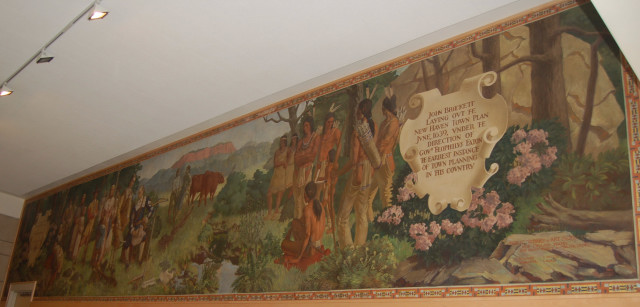

PWAP Project No. 6- Mural
-
Artist: Vincent Mondo, Stanly Novicki, Lois North, Aldis Brown, Henry Skzeczko Date: February 14, 1934 Material: Aluminum
-
Dimensions: 5’4’ x 28’6’ Location: Fair Haven K-8
-
Sponsor: Board of Education
-
Description: John Brockett, surveyor, laying out the nine squares of the New Haven Green in 1638
10
Materials:
-
Pencil or Pens
-
Student Journals
Background Information:
PWAP Project No. 6- Mural is located at Fair Haven Middle school, a few blocks from Columbus School. Many of my students have been inside this school or have family that attends the school itself. The placement within the community, as well as its significance to New Haven’s history will provide an interesting topic for my students. This mural will offer insight into the way people of the 1930’s viewed Native Americans and bring to their attention the planning that went into the city’s layout.
Observations/Descriptions:
Students will be asked to visually observe and record this installation using a pen and ink or pencil drawing demonstrated in class. Once students have completed their drawings they will answer the following questions:
-
What emotions does this artwork evoke and why?
-
Who has the artist portrayed?
|
What time period do you believe the people in this mural are from? And why?
|
|
-
(Look at clothing and artifacts in the mural to answer this question)
-
Why might this moment in time be important to New Havens History?
-
What are some other questions you may have about the artwork?
-
Who do you believe may have commissioned this artwork and why?
-
What influenced the artist more the patron or environment?
Student will learn about this mural by completing research concerning the original nine squares of New Haven as well as its original inhabitants, the Quinnipiac Indians. More then one artist was responsible for this project so we will discuss possible group dynamics as well as the artists themselves and the patrons involved.
Interpretation:
Students will compare and contrast their pre and post interpretations of the mural. This will be done by answering their initial questions a second time. Students will be asked to first write and discuss their misgivings or correct assumptions and discuss what changed their opinions or solidified them.
Resources:
http://www.quinnipiac.edu/other/abl/etext/oldnew/oldnew.html visited July 27, 2008 a website containing STORIES OF OLD NEW HAVEN [ILLUSTRATED] By Ernest H. Baldwin, Ph. D. Formerly Instructor in History, Hill House High School, New Haven, Conn., and Lecturer in History, Yale University, C. A. HACK AND SON, PUBLISHERS TAUNTON, MASS, U.S.A.
http://www.cityofnewhaven.com/Mayor/History_New_Haven.asp visited July 29, 2008 City of New Haven, Government Office of the Mayor brief history of New Haven, Native Americans and The Puritan Settlement
Suggested Lesson Three
Objectives:
-
Students will develop critical thinking and observation skills
-
Students will be exposed to a variety of mediums and locations of public art.
-
Students will be introduced to the Regicides
-
Students will experiment with pencil drawing techniques
Artwork:
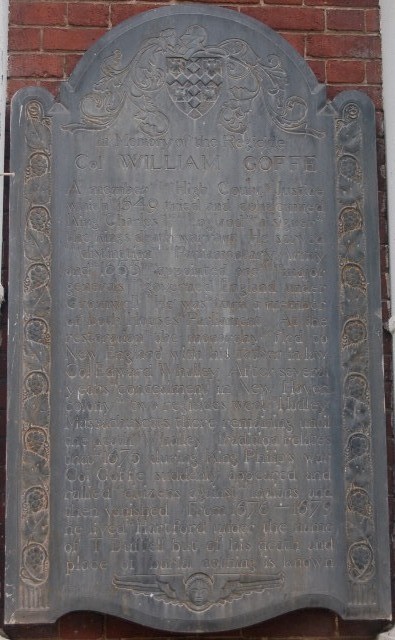
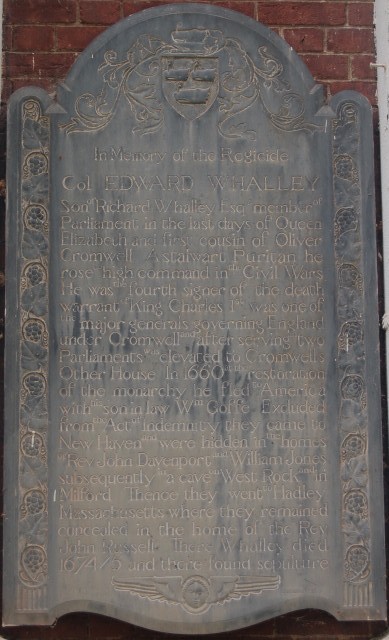
CWA, FERA project Nos, 34.35.36 - Regicide Plaques
-
Artist: Salvador Milki and Peter Saldibar
-
Date: begun September 1934
-
Material: Slate and white marble
-
Dimensions: 50’ x 30’ Location: New Haven Center Church, north side
-
Sponsor: Center Church
-
Description: The regicides Edward Whalley, William Goffe, and John Dixwell with inscriptions and their coats of arms
11
Materials:
-
Journals
-
Pencils
Background Information:
Whalley, Goffe, and Dixwell are three names that are well known to my students since they travel streets named after these figures on a regular basis. My hope is that this will spark their interest in the stories behind these three men. This installation resides on the New Haven Green, another place my students visit often. It will be interesting to see how many have passed them by. We will also find interesting the topic of stone carvings and where the stone quarries exist. My personal archival research led me to the realization that the intent was three plaques to honor the three regicides. However, when I arrived on the scene of the plaques I found only Whalley and Goffe. Dixwell’s monument had been commissioned at an earlier date. When the students witness this idea of one man being honored before another it will create a means for further inquiry into the politics of the time.
Observations/Descriptions:
Students will be asked to visually observe and record this installation using a pen and ink or pencil drawing demonstrated in class. Once students have completed their drawings, they will answer the following questions as a form of analysis:
-
What emotions does this artwork evoke and why?
-
Who do you believe is represented in this installation?
-
Why do you believe this site was chosen for such an installation?
-
Who may have commissioned this installation and why?
Analysis:
The students will research this installation by discovering information on the regicides, Edward Whalley, William Goffe, and John Dixwell. We will investigate the art of stone carving, and discuss the patrons for this installation.
Interpretation:
Students will compare and contrast their pre and post interpretations of the sculpture. This will be done by answering their initial questions a second time. Students will be asked to first write and discuss their misgivings or correct assumptions and discuss what changed their opinions or solidified them.
Resources:
http://www.colonialwarsct.org/1660.htm visited July 27, 2008 a website from The Society of Colonial Wars in the State of Connecticut
Suggested Lesson Four
Objectives:
-
Students will develop critical thinking and observation skills
-
Students will become aware of the changes public art may encounter from removal or change due to the public in the form of petition or vandalism.
-
Students will become aware of the tradition of oystering in Fair Haven
-
Students will experiment with pen and ink drawing techniques
Artwork:
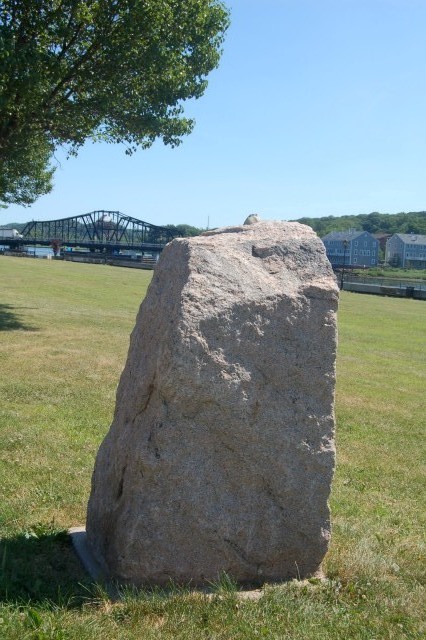
Seaman Sculpture
-
Artist: Karen Rossi Date: 1993 Material: Bronze and Stony Creek granite Location: Quinnipiac Park near the center of the Park (stolen: only granite block remains)
-
Sponsor: Percent for Art project
-
Description: This humorous sculpture was intended to remind the viewer of Fair Haven’s rich background in oystering, claming, and shipbuilding. Unfortunately, this artwork was stolen.
12
Materials:
-
Student Journals
-
Drawing pens
Background Information:
The
Seaman Sculpture
once resided a mile or so down the street from Columbus School. The sculpture was to tell the story what Fair Haven once was. The history of oystering is rich in this community and important as such. The tragedy of the sculpture having been stolen will show my students that, although these public works are intended to be timeless, things happen; whether it be through mistakes or politics, not all are permanent.
Observations/Descriptions:
Students will be asked to visually observe and record this installation using a pen and ink method demonstrated in class. Once students have completed their drawings they will answer the following questions:
-
What emotions does the artwork evoke and why?
-
Why do you believe the artist chose this medium?
-
What message do you believe the artist is trying to project and why?
-
Who do you believe may have commissioned this artwork and why?
-
What influenced the artist more the patron or environment?
-
Is this a complete artwork?
Analysis:
Students will research the history of oystering in Fair Haven and the artist before revisiting the questions.
Interpretation:
Students will compare and contrast their pre and post interpretations of the sculpture. This will be done by answering their initial questions a second time. Students will be asked to first write and discuss their misgivings or correct assumptions and discuss what changed their opinions or solidified them.
Resources:
http://www.karenrossi.com/ visited July 27, 2008 a website about Karen Rossi and her art
http://www.nhpt.org/History%20Pages/1825_1865.htmvissited July 27, 2008 a website by the New Haven Preservation trust concerning the growth of oystering
http://www.cityofnewhaven.com/EconomicDevelopment/Percentforart/seaman.asp
visited July, 27 2008 this web address will lead you to New Havens Percent for Art description of the Seamen Sculpture
Suggested Lesson Five
Objectives:
Students will develop critical thinking and observation skills
Students will recognize the varied styles of art used in today’s public art
Students will experiment with watercolor paints
Artwork:
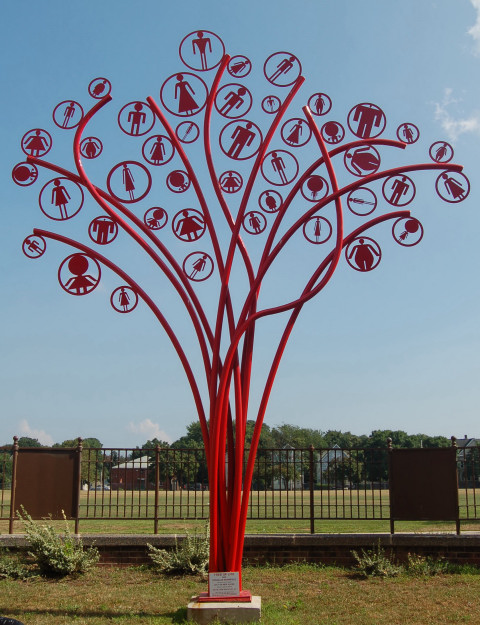
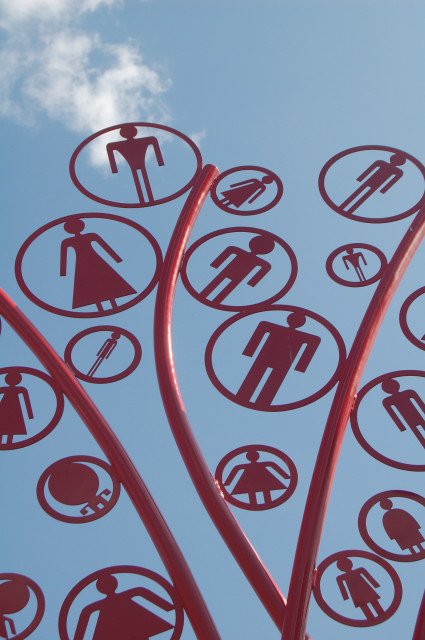
The Tree Of Life
-
Artist: Douglas Kornfeld
-
Date: 2004-2005
-
Material: steel
-
Location: Courtyard, Clinton Avenue School. 293 Clinton Avenue.
-
Sponsor: Percent for Art project
-
Description: This artwork is intended to represent people of various backgrounds coming together in one community
Materials:
-
Student Journals
-
Watercolor paints
-
Pencils
Background Information:
Students will be asked to visually observe and record this installation using watercolor techniques demonstrated in class. Once students have completed their observations they will answer the following questions:
-
What emotions does the artwork evoke and why?
-
Why do you believe the artist chose this medium?
-
What message do you believe the artist is trying to project and why?
-
Who do you believe may have commissioned this artwork and why?
-
What influenced the artist more the patron or environment?
Analysis:
Students will research the similarities and differences that make up their community
Interpretation:
Students will compare and contrast their pre and post interpretations of the sculpture. This will be done by answering their initial questions a second time. Students will be asked to first write and discuss their misgivings or correct assumptions and discuss what changed their opinions or solidified them.
Resources:
http://www.awaka-inc.com/ visited July 29, 2008 Biography of Douglas Kornfeld and his artwork
Suggested Lesson Six
Objectives:
-
Students will develop critical thinking and observation skills
-
Students will become aware of obstacles that occur during the production of public works of art
-
Students will experiment with watercolor paints
Artwork:
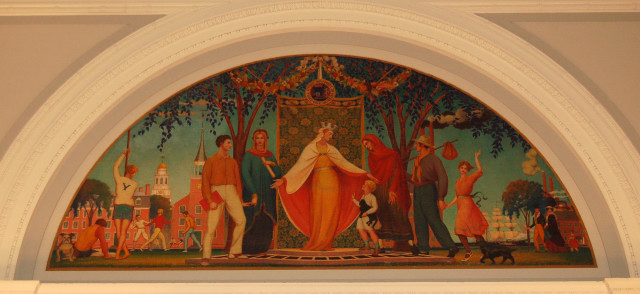
First Lunette project No- 12
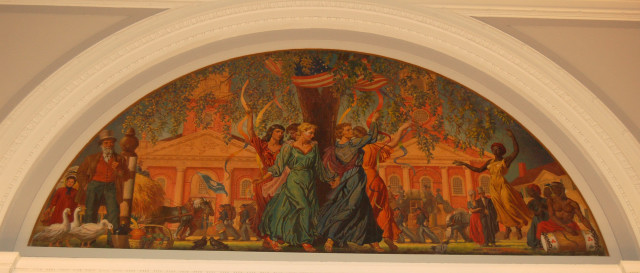
Second Lunette Project No- 57
PWAP project No- 12 and No- 57
-
Artist: Bancel LaFarge until his death in 1938 completed by Dean Keller
-
Assistants: Thomas Guidone, Christopher McLoughlin, and Louis Agustino
-
Date: June, 1942
-
Material: Beeswax and color on canvas
-
Dimensions: 22’ x18’ Location: New Haven Public Library - Main Room
-
Sponsor: Library Board
-
Description: Personification of New Haven receiving new immigrants and learners
13
Materials:
-
Student Journals
-
Watercolor paint
-
Pencils
Background Information:
The theme of the first of three architectural lunettes portrays immigration, higher education and everyday life in New Haven. Many of my students are recent immigrants to New Haven and the US. This being said I believe observing this interpretation of New Haven in the1930’s and being aware of it today will lead to interesting observations and analysis. The second lunette’s theme is of the slaves of the Amistad on the New Haven Green. This is a true David and Goliath story that many an author and artist have portrayed. Students will discover that the third lunette was never begun. We can create many ideas for what should or could have been placed within the empty space.
Observations/Description:
Students will be asked to visually observe and record this installation using a pen and ink or pencil drawing demonstrated in class. Once students have completed their drawings they will answer the following questions:
-
What emotions does this artwork evoke and why?
-
What message do you believe the artist intended to portray and why?
-
Who do you believe is represented in this painting?
-
For each lunette give a reason for possible artist intent?
-
Why might the patrons have requested such paintings?
Analysis:
Students will research this artwork by discussing immigration in New Haven today and learning how it differed in the 1930. Students will research a brief history of the Amistad and how it pertains to New Haven. Students will also discuss the political ramifications of this installation.
Interpretation:
Students will compare and contrast their pre and post interpretations of the murals. This will be done by answering their initial questions a second time. Students will be asked to first write and discuss their misgivings or correct assumptions and discuss what changed their opinions or solidified them.
Resources:
http://www.ctheritage.org/encyclopedia/topicalsurveys/immigration.htm visited July 27, 2008 this is a site about immigration in Connecticut
Suggested lesson Seven
Objectives:
-
Students will develop critical thinking and observation skills
-
Students will engage in artistic discourse with people outside their peer groups
-
Students will experiment with the artist media of their choice
Artwork:
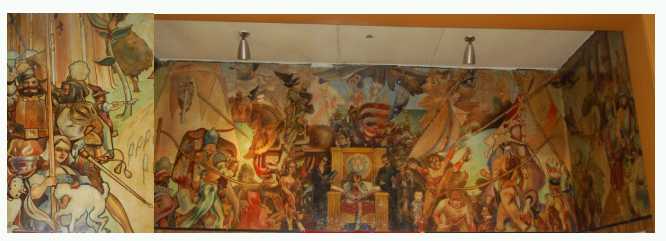
CWA, FERA project No. 49 Mural
-
Artist: A. Reid Winsey
-
Date: Unlisted
-
Material: Tempera on wall board
-
Dimensions: 29’ 3’ x 7’
-
Location: Atwater Training School (now Atwater Senior Center), Back of Stage
-
Sponsor: Parent Teacher Association
-
Description: Characters from Juvenile Fiction
14
Materials:
-
Student Journals
-
Artist media of choice
Background Information:
Our school has an ongoing partnership with the Atwater Senior Center. Students visit the center on a volunteer basis throughout the school year to play bingo, help the seniors plant their garden, and pass out food baskets. This relationship already being in place creates the perfect opportunity for the students to engage in a dialogue with people of a different era and to form their own analysis from oral history and stories behind the PWAP. The students may also become aware of the changes that have occurred in public education and children’s literature.
Observations/Description:
Students will be asked to visually observe and record this installation using a pen and ink or pencil drawing demonstrated in class. Once students have completed their drawings they will answer the following questions:
-
What emotions does the artwork evoke and why?
-
Why do you believe the artist chose this medium?
-
What message do you believe the artist is trying to project and why?
-
Do you recognize any of the images portrayed in this installation? Name them.
-
Who do you believe may have commissioned this artwork and why?
Analysis:
Students will research this installation by collecting the oral history of the seniors who currently occupy the center
Interpretation:
Students will compare and contrast their pre and post interpretations of the artwork. This will be done by answering their initial questions a second time. Students will be asked to first write and discuss their misgivings or correct assumptions and discuss what changed their opinions or solidified them.
Final Project
Objectives:
-
Students will develop critical thinking and observation skills.
-
Students will partake in a real life experience of working as an artist for a community of patrons.
-
Students will apply their art making skills.
-
Students will engage in a group project and work as a team.
Tasks:
-
Students will be asked to create their own proposal for a Percent for Art Project following the guidelines and rules of the program.
-
Students will choose a location within the school to display the work.
-
Students will listen to the requests of a committee made up of representatives from the faculty, and student body of our school.
-
The committee will limit proposals to three artists.
-
These artists will display their proposals for the school community to write comments.
-
The committee will make a final vote and the artist chosen will be given a chance to create an artwork for our building.
Additional Activity
Tour of the PWA installation at The New Haven Historic Society
Objectives:
To broaden the students base of knowledge surrounding the New Deal Era
To become aware of the vast number of PWA artworks in New Haven and the many styles of art created during this time.